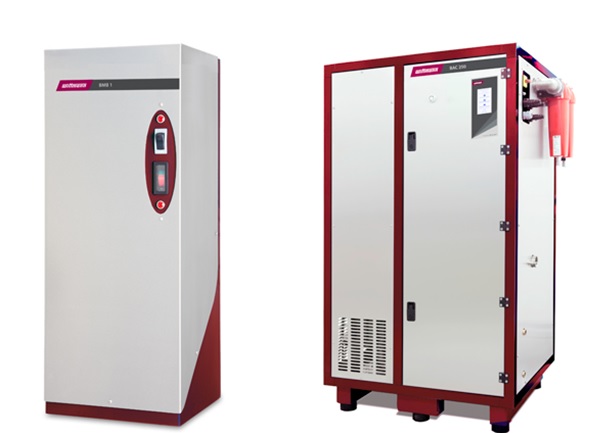Internal Air Cooling Systems (IACS) in blow molding
25.12.2020
WITTMANN’s innovative Internal Air Cooling Systems (IACS) in blow molding operations, shorten cooling times, reduce stresses in the finished product, and decrease crystallization rates.

WITTMANN Internal Air Cooling Systems (IACS) for blow molding: Blow Molding Booster (BMB, left) and Blow Air Chiller (BAC).
In all blow molding methods throughout the plastics industry, one of the most critical steps is the cooling of the plastic parts. Selecting the right technology for this work step can yield the greatest time and material savings.
In blow molding, parts are typically formed by injecting compressed air, which presses the hot material out against the mold surface from within, whereupon the parts are then cooled along the walls of the mold merely by means of cold water. This not only creates material stresses due to the temperature difference between the inner and outer wall of the parts, but it also results in a significantly slower rate of heat removal because that removal takes place exclusively through the outer wall of the formed parts. And that’s where the Internal Air Cooling Systems (IACS) from WITTMANN make all the difference. The added cooling of the inner wall of the parts by cold compressed air generally increases production by at least 15%, whereby considerably better values can be achieved in most cases. Moreover, the lower material stresses make significant material savings possible, reducing the weight of the finished product by up to 10% while ultimately still passing the same leak, drop and strength tests as before. Experience has shown that the amortization period for such internal air cooling systems is much less that one year.
Any Internal Air Cooling System starts with a compressed air cooler. In this case, that means either the WITTMANN Blow Molding Booster (BMB), which produces a compressed air temperature of about 5 °C, or else the Blow Air Chiller (BAC), which cools the compressed air down to about -35 °C. Specially developed Blow Valve Blocks (BVBs) control the various processes via a control box: the flow of the compressed air through a core pin into the interior of the product and the subsequent discharge of compressed air out of the product via controlled ventilation. Each individual product to be cooled in this way in the blow molding process requires the development of its own special core pin. This is because the precise distribution of the air to be established inside differs from one product to another. That distribution, together with the right balance of supply and exhaust air, plays a hugely important role here.
Production increase of up to 50% or more
The Blow Molding Booster (BMB) was specially developed with certain properties in mind – properties which now characterize it. It is compact, inexpensive, maintenance-free, and – in terms of the quality of the compressed air used – features perfectly simple operation. The air discharge temperature always remains above freezing, thereby eliminating the need for a complicated system to dry the compressed air and obviating the question of which oil to use in such a system. The only requirements are compressed air pressure between 6 and 15 bar and an adequate supply of cold filtered water that does not exceed 15 °C. Blow Molding Booster units are available in three different sizes with compressed air capacities ranging from 160 to 600 Nm³/h and generally achieve production increases ranging from 10 to 35%. In most cases, the compact design of these devices enables direct installation on the production machine, which keeps supply lines short and production floors clear.
The design of the Blow Air Chiller (BAC) is considerably more complex. It also demands suitably high-quality compressed air ranging in pressure from 7 to 15 bar with a residual oil content of 0.01 mg/m³ and a pressure dew point of 5 °C at 7 bar (or lower). The molecular sieve in use here also requires maintenance from time to time. This expense yields production increases ranging from 15 to above 50%. In some cases, blowing and ventilation time could even be cut to one third of the original value. With the Blow Air Chiller, the compressed air is fed through the internal Pressure Air Dryer (PAD) equipped with a molecular sieve, which regenerates itself simply by means of dry compressed air. The dew point of the process air is lowered to -40 °C to prevent ice from forming in the system. The Blow Valve Blocks that control the processes are designed to operate at such low temperatures. Like the Blow Molding Booster, the Blow Air Chiller also requires a cold water supply with a maximum temperature of 15 °C – at a pressure of 3 to 8 bar. WITTMANN Blow Air Chillers are equipped with an integrated FIT controller, a control display for visualizing the process and accessing all relevant device data. The user can also store data and use special control functions to pass it along to other process machinery.
WITTMANN Group’s specialists offer a full range of consulting services for all internal air cooling systems. Following a comprehensive review of their system requirements, each customer receives a customized, free-of-charge quotation, including an estimate of the expected production increase.




































